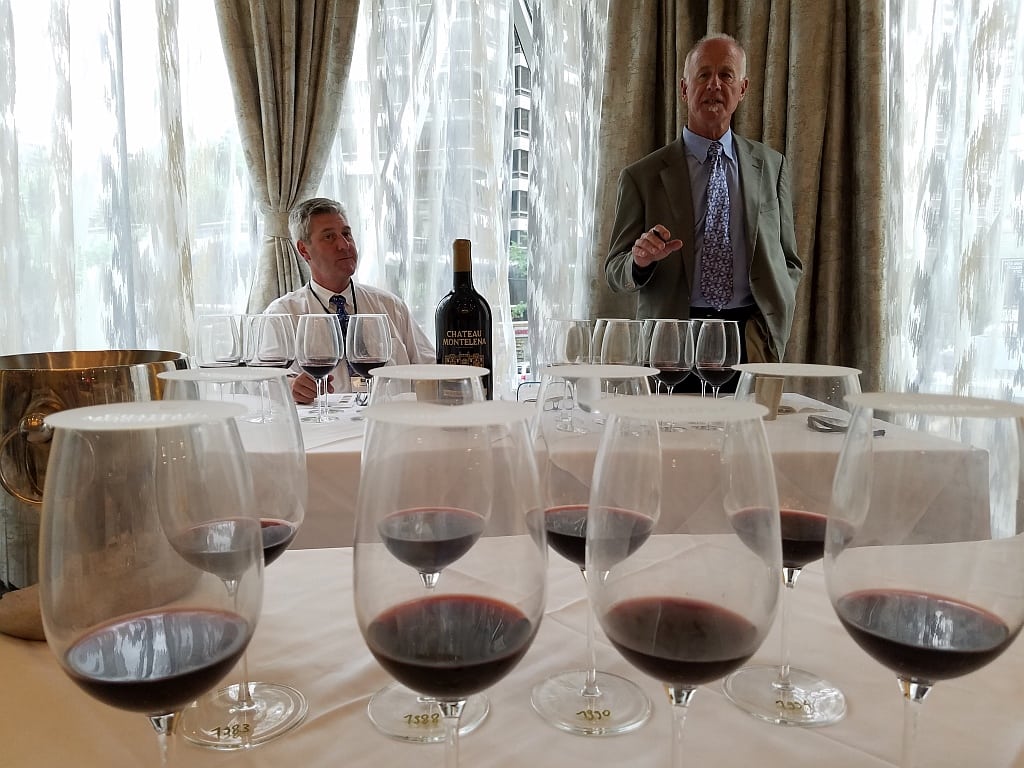Bo Barrett presenting The Dream Tasting in NYC
The first of a two-part series.
It may be from California, but Chateau Montelena got its fame in Paris when its 1973 chardonnay bested a handful of Burgundy’s great white wines in the 1976 Judgment of Paris tasting.
A few months ago in Manhattan, winemaker and owner Bo Barrett presented a unique tasting that spanned 40 years of Chateau Montelena Estate cabernet sauvignon. He told the story of how his father, attorney James Barrett, purchased the abandoned property in Calistoga in 1972. He hired winemaker Mike Grgich and began the process of rebuilding the entire estate—from replanting vines to building a new winery. To help offset the enormous expenses of the project, Grgich produced a chardonnay and riesling from purchased grapes, from which the triumphant 1973 chardonnay was made. It was a stunning victory for the embryonic winery and catapulted it through the wine world.
But the Paris triumph did not change Barrett’s vision of Chateau Montelena as a cabernet sauvignon-focused winery. Until 1978, the winery’s cabernet sauvignon was made with purchased grapes (it now produces its own quality fruit). Here are the tastings throughout the years.
We began with the 1974 Chateau Montelena Cabernet Sauvignon, an iconic vintage in California’s modern history. It was made from Sonoma fruit, equal parts Russian River valley and Alexander valley. Its rusty red color, pungent raspberry, herbal, and black-raisin aromas were matched by an earthy, red-fruit taste carried on a medium body. The tannins were soft, and a mineral backbone underscored the red fruit-flavored finish. It was a pleasure to taste, and a reminder that 12.5% to 13% alcohol was the standard only a few decades ago. 90 points.
The 1975 Chateau Montelena was made from north coast fruit; it and the 1979 Chateau Montelena Estate, were from challenging vintages and not at the level of the 1974.
As we tasted three vintages from 1980s, Barrett explained that Montelena’s vineyards are made of alluvial, volcanic and sedimentary soils. Each contributes to the wine’s structure and flavor profile. He pointed to the earthy and flavor concentration that alluvial soil brings, the spicy, cedar-y and minty accents from the well-drained volcanic rock, and the nutrients and organic matter in sedimentary loamy soils that add to the ripe berry, herbal and fruit character.
Barrett noted the advantage of Montelena’s sloping rocky soil in 1983 “El Nino” vintage with its heavy winter rains and fall rainstorms. The vines and fruit remained healthy, able to produce ripe fruit when October’s Indian summer arrived. For me, the 1983 Chateau Montelena Cabernet Sauvignon Estate had better fruit flavors and balance than those from 1980 and 1988.
The 1990s marked the transition from the heretofore translucent purplish-black- cherry color and 13% (or less) alcohol to wines with an opaque blackish hue and alcohol level rising towards 14% and higher.
The 1990 Chateau Montelena Estate Cabernet Sauvignon had a nose of raisin, black-fruit and tobacco and rich, black-fruit and tobacco flavors, which were substantially different from the prior wines. With its long finish and very good structure, this wine has many more years of life. 92 points. Retail prices range from $123 to $295.
During the last couple years, I’ve heard comments from wine collectors and a few wine writers about the decline of the 1994 Napa cabernets. I don’t know which wines they were drinking, or where the wines were stored, but I can tell you that is not the case for the 1994 Chateau Montelena Estate Cabernet Sauvignon, nor many others, such as Stag’s Leap Wine Cellars Fay and SLV vineyards, Heitz’s Martha’s Vineyard, Phelp’s Insignia, and just about any hillside vineyard wine.
The 1994 Montelena Estate cabernet sauvignon is an opaque cherry-colored with a nose blooming with floral, herbal and red-fruit scents. Its medium body is filled with ripe, blackberry and tobacco flavors with harmonious tannins. This 1994 has decades of life before it. 93 points. Retail prices range from $150 to $265.
The third wine in the 1990 series was the dark 1996 Chateau Montelena Estate Cabernet Sauvignon. Born in a dry, hot vintage, black-raisin and black-cherry aromas dominated the nose. Its elegant texture is lined with blackberry, vanilla and tobacco flavors integrated with soft tannins. It is a delicious wine and surprisingly young. 93 points. Retail prices range from $100 to $132.
Next week: The new millennium Chateau Montelena Estate Cabernet Sauvignon wines.
Photos by John Foy









Leave A Comment